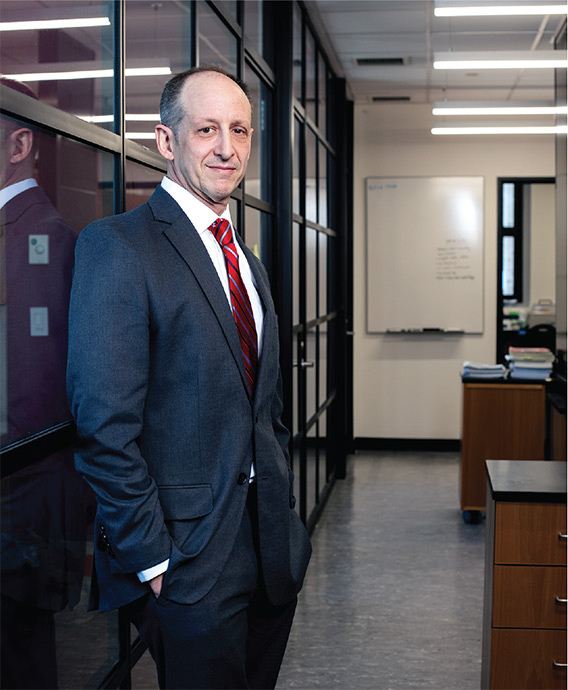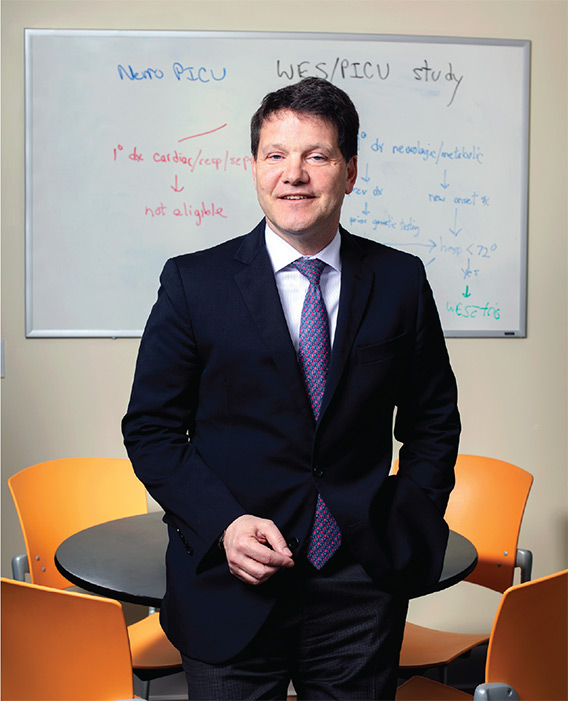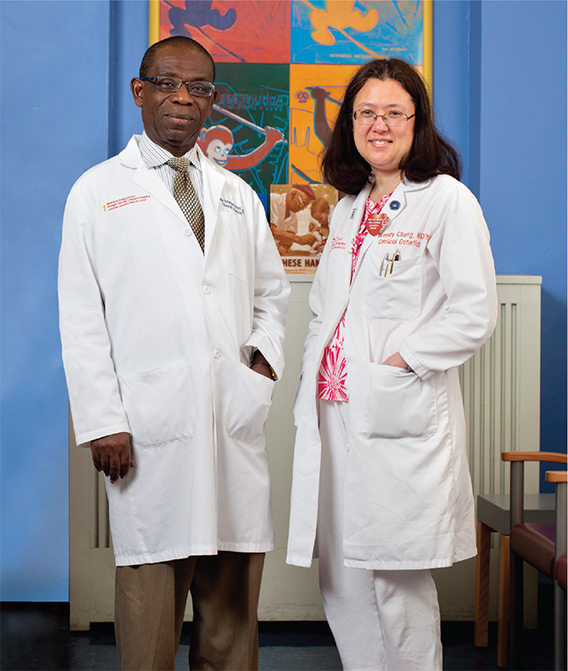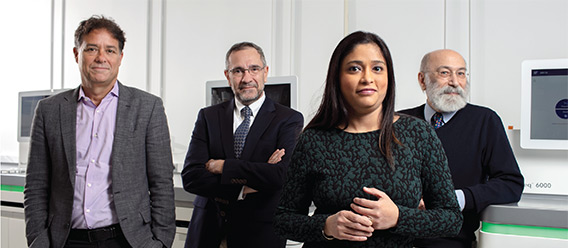Adding Hope to List of Diagnostic Tests for Sick Children
The baby who arrived in the pediatric intensive care unit one winter day was floppy and too weak to breathe without assistance, having been referred to Columbia so the family could seek the expertise of Darryl De Vivo, MD, a metabolic diseases specialist.
Suspecting a metabolic disease with a genetic cause, Dr. De Vivo and Steve Kernie, MD, chief of pediatric critical care medicine, turned to Columbia’s Institute for Genomic Medicine to sequence the child’s DNA as quickly as possible.
The results pointed to a mutation that was likely causing the disease. Dr. De Vivo learned of a mouse model that carried this mutation, which accelerated the development of an experimental medicine. After consulting with pediatrician James Garvin, MD, PhD, and obtaining FDA approval, the team administered the treatment to the baby, who responded successfully.
“This is a disease that has been described in the literature 20-some times, and no child has survived past 26 months,” says Dr. Kernie. Yet this patient, now a walking, talking preschooler, is a sequencing success story.
The medical professionals in the NICU and PICU do not always see this kind of happy ending, but the growing use and influence of precision medicine provide potential for more happy endings. For now, though, sequencing is no panacea for severe childhood illnesses. Successes like the one described above are still a rarity.
 Jordan Orange
Jordan Orange“The benefits that we are all hoping for—where a genetic diagnosis gives you a new therapeutic option that helps significantly—is still very much the exception,” says David Goldstein, PhD, director of the Institute for Genomic Medicine, or IGM. “That’s only because we don’t yet know how to treat most of these genetic diseases.” However, say Dr. Goldstein and other experts, sequencing is an especially powerful tool for diagnosing babies and young children with conditions grave enough to bring them to the ICU.
“Sick children, by their very nature, are much more likely than adults to have a genetic condition. That’s just a biological fact,” says Wendy Chung, MD, PhD, an expert in precision medicine and rare diseases. “That means that getting their genome sequenced is much more likely to lead to a diagnosis or an improvement in their care. And the younger they are, the more likely it is that we will identify a genetic cause for their symptoms.”
As researchers and physicians continue to learn more about the genetic basis of rare diseases, the clinical utility of sequencing will only increase. Because of the location of Columbia and NewYork-Presbyterian in an urban center that attracts some of the most complex perinatal, neonatal, and pediatric cases from throughout the world, precision medicine specialists at the university and hospital are at the forefront of harnessing this technology for the benefit of its youngest patients, sometimes even before they are born.
“What we are doing is building an integrated environment for genetics in the clinic,” says Jordan Orange, MD, PhD, chair of pediatrics. “Any baby or child sick enough to warrant being in the ICU deserves to be sequenced. By applying these approaches broadly to the very sick children who come to this institution, we can provide the best outcomes for these patients.”
Dr. Orange, who joined Columbia in 2018, is driven by a deep conviction in the power of sequencing in pediatric patients. At his previous position at Baylor College of Medicine in Texas, he worked with Jim Lupski, considered one of the founders of precision medicine, on the first large-scale study to examine the benefits of sequencing children with rare immune diseases called primary immunodeficiency disorders, which are associated with mutations in some 300 genes. Sequencing could definitively diagnose 40% of these patients, and for a third of those, that diagnosis changed how their doctors took care of them.
Other studies, too, are accumulating to show the value of sequencing in different types of rare diseases, and in the ICU, the conditions kids have are almost always by definition rare. “Quite frankly, we need to make the journey more efficient for such patients,” says Dr. Orange.
Columbia does exome sequencing for any child admitted to the neonatal or pediatric ICU.
Kwame Anyane-Yeboa, MD, chief of the clinical genetics division in the Department of Pediatrics, collaborates with the IGM in researching undiagnosed genetic diseases. He has dedicated his career to uncovering the molecular basis for complex and often rare genetic disorders. “In earlier cases,” says Dr. Anyane-Yeboa, “we found that sequencing significantly improved our diagnostic ability, and we addressed many practical problems, like patient education, consent, and insurance coverage, that will help us as we sequence more children.”
Generally, clinical sequencing involves sequencing just the exome, the 1% of the genome that encodes proteins. In most cases, mutations that cause disease are thought to occur in exons. Exome sequencing can help guide care of prenatal, neonatal, and pediatric patients in many ways.
 Steve Kernie
Steve Kernie“Sequencing the genome of children with complex genetic diseases is the best way to elucidate the molecular basis for complex diseases, and in most cases a first step in understanding their diseases,” says Dr. Anyane-Yeboa. “Knowledge of the molecular basis for complex diseases leads to better focused care and will ultimately provide a pathway to cure for such diseases.”
For the small handful of children, like the patient with metabolic disease, it both identifies the condition and points to an effective treatment. Patients who are confirmed to have certain specific mutations also can become eligible for a clinical trial. In less hopeful cases, identifying a mutation known to be fatal can help the family decide how intensively to pursue treatments and interventions. In addition to providing information on the outcome for a child, sequencing results that reveal the genetic status of a condition also can help guide future reproductive decisions for parents.
As the science advances, the list of conditions for which sequencing can provide important information is growing. Indeed, studies suggest that even babies who present with chronic disease not thought to be within the diagnostic sights of comprehensive sequencing might have some constellation of genetic mutations that make them more susceptible. “Five years ago, we mostly thought about genetic testing for kids with congenital structural anomalies,” says Dr. Kernie. “Now we know that kids who are really ill for whatever reason—whether it’s a metabolic, immunologic, or neurologic disease or even a predisposition to infectious disease—oftentimes have a genetic component that we really need to understand before we can effectively treat them.”
Increasingly, the approach is being extended to the prenatal period in patients for whom ultrasounds detect certain abnormalities. In fact, says Dr. Chung, sequencing prenatally is often preferable, if parents and physicians have reason to suspect a problem. Recent studies, including one published by Columbia researchers in February in the Lancet, support the idea that in certain cases sequencing can add much more information than current prenatal tests offer. “That means before the baby is even born we know what we’re dealing with, we have a game plan, we have the right doctors lined up, and we have families who can emotionally prepare and wrap their heads around the situation.”
 Kwame Anyane-Yeboa and Wendy Chung
Kwame Anyane-Yeboa and Wendy ChungSometimes, sequencing identifies mutations that have never been described. “It’s a bit nerve-racking but scientifically very interesting that we have 20,000 genes in our genome but we only know what diseases about 4,000 of them cause,” says Dr. Chung. Novel mutations can leave clinicians and scientists groping for answers, but they also plant the seeds for new scientific discovery that may lead to therapies down the line. “We are still in the learning process. This plane is not completely built, and yet we’re flying it—because it offers us some tremendous opportunities. As we say here at Columbia, we don’t just practice medicine; we really think about what the next wave of medicine should be, and we develop it.”
Columbia’s commitment to leadership in clinical sequencing—for both children and adults—has a foundation in the Institute for Genomic Medicine created in 2015. Patients thought to have a condition that is at least partially genetic get their exomes sequenced by being enrolled into a research protocol at the IGM. That means the IGM absorbs the costs, which is beneficial for patients because insurance reimbursement is not an issue. However, for the information to become part of a patient’s medical record, the identified mutations must be confirmed in a clinical laboratory. That confirmation typically occurs in a clinically accredited laboratory in the Department of Pathology & Cell Biology.
Dr. Goldstein and Kevin Roth, MD, PhD, chair of pathology & cell biology, devised a centralized solution for the two-step process, a single laboratory called the Precision Genomics Laboratory (PGL). The laboratory combines the strengths of both entities: the precision medicine research and high throughput genomic sequencing expertise wielded by Dr. Goldstein’s team and the clinical expertise and knowledge of laboratory testing and regulatory and reimbursement issues within Dr. Roth’s team.
 Vimla Aggarwal, director of the Precision Genomics Laboratory, with other lab leadership, from left, David Goldstein, Kevin Roth, and Steven Spitalnik
Vimla Aggarwal, director of the Precision Genomics Laboratory, with other lab leadership, from left, David Goldstein, Kevin Roth, and Steven Spitalnik“The two of us realized that between us we have complementary expertise, and that by combining it we can really move our sequencing efforts from a research setting to a clinically applicable patient-facing setting that would maximally benefit patients,” says Dr. Roth. “It’s very unusual to have a basic science genomics institute like the IGM partner so closely with clinical laboratories in a pathology department in such a productive fashion. The aim is for Columbia to be able to cover the whole gamut, from initial discovery and analysis all the way to clinical testing mode.”
Vimla S. Aggarwal, MBBS, assistant professor of pathology & cell biology (in the Institute for Genomic Medicine) and director of the Precision Genomics Laboratory
Kwame Anyane-Yeboa, MD, professor of pediatrics at CUMC and chief of the Division of Clinical Genetics
Wendy Chung, MD, PhD, the Kennedy Family Professor of Pediatrics (in Medicine)
Darryl C. De Vivo, MD, the Sidney Carter Professor of Neurology, professor of pediatrics, and director emeritus of the pediatric neurology service
James H. Garvin Jr., MD, PhD, professor of pediatrics
David Goldstein, PhD, the John E. Borne Professor of Medical and Surgical Research (in Genetics & Development, in the Institute for Genomic Medicine, and in Neurology), professor of medical sciences (in medicine), and director of the Institute for Genomic Medicine
Steven G. Kernie, MD, professor of pediatrics (in neurology), vice chair for clinical affairs for the Department of Pediatrics, and chief of critical care medicine at NewYork-Presbyterian’s Morgan Stanley Children’s Hospital
Jordan Orange, MD, PhD, the Reuben S. Carpentier Professor of Pediatrics and chair of the Department of Pediatrics
Kevin Roth, MD, PhD, the Donald W. King, MD, and Mary Elizabeth King Professor of Pathology & Cell Biology and chair of the Department of Pathology & Cell Biology
With the genomics laboratory in place, physicians can now do exome sequencing for any child admitted to the neonatal or pediatric ICU, in the same way that the Precision in Pediatric Sequencing program has provided genome sequencing for every pediatric cancer patient. Ultimately, says Vimla Aggarwal, MBBS, director of the PGL, the vision is to provide these kids with a rapid sequencing protocol.
With a sequencing protocol in place, improving speed of sequencing will be the next goal. In a review of pediatric ICU admissions data from 2015 and 2016, Dr. Kernie and his colleagues found that although just a small percentage of patients—1% to 2% of the total admitted—were referred for sequencing, the testing yielded a positive diagnosis in a full 25% of them. That number was especially high for certain specific groups of patients under age 2, boosting support for routine sequencing in the youngest patients. But unlike Dr. Kernie’s infant patient with metabolic disease, whose sequencing and diagnosis was completed in close to two weeks, the process often took as long as four months. The Precision Genomics Laboratory is working toward a turnaround time of two to three weeks, which would reduce hospital stays and distress for families.
Speed aside, the sequencing that Columbia offers already sets it apart. “When I talk to my colleagues around the country, nobody has the ability to do what I’m doing, which is essentially to offer sequencing to everybody who comes into the pediatric ICU,” says Dr. Kernie.
In addition to helping patients, Columbia’s growing sequencing capacity is also powering the research engine that will deliver future therapies, work that is often painstakingly slow. “The process may be slow, but there is no doubt that it will pay off,” says Dr. Goldstein. “As we slowly find treatments for more and more of these diseases, a higher percentage of the patients diagnosed will be helped by effective treatments.”
- Log in to post comments


